[ p. 456 ]
CLOSE OF THE OLD STONE AGE — INVASION OF NEW RACES — HISTORY OF THE MAS D’AZIL, OF FÈRE-EN-TARDENOIS — FOREST ENVIRONMENT AND LIFE — ORIGIN OF THE AZILIAN-TARDENOISIAN CULTURE— CHARACTERS AND CUSTOMS OF THE NEW RACES — TRANSITION TO THE NEOLITHIC AND RELATIONS OF THE OLD AND NEW RACES — APPARENT CHIEF LINES OF HUMAN DESCENT AND OF HUMAN MIGRATION INTO WESTERN EUROPE.
We have now reached the very close of the Old Stone Age, a period which is believed to extend between 10,000 and 7,000 years before the present era. The entrance to the final cultures of the Upper Palaeolithic, known as the Azilian-Tardenoisian, marks a transition even more abrupt than that witnessed in any preceding stage. It is not a development; it is a revolution. The artistic spirit entirely disappears ; there is no trace of animal engraving or sculpture; painting is found only on flattened pebbles Or in schematic or geometric designs on wall surfaces. Of bone implements only harpoons and polishers remain, and even these are of inferior workmanship and without any trace of art. The flint industry continues the degeneration begun in the Magdalenian and exhibits a new life and impulse only in the fashioning of the extremely small or microlithic tools and weapons known as ‘Tardenoisian.’ Both bone and flint weapons of the chase disappear, yet the stag is hunted and its horns are used in the manufacture of harpoons. This is the ‘Age of the Stag,’ the final stage of the ‘Cave Period’ in western Europe, and is subsequent to the ‘Age of the Reindeer’ in the south.
It would appear as if the very same regions formerly occupied by the great hunting Crô-Magnon race from Aurignacian to Magdalenian times were now inhabited by a race or races largely employed in fishing. The country is thickly forested. [ p. 457 ] The climate is still cold and extremely moist, and human life every-where is in the grottos or entrances to the caverns.
¶ Invasion of Four New Races in Closing Upper Palaeolithic Times
How far this revolution is due to the decline of the Grô-Magnon race and how far to the invasion of one or more new races is very difficult to determine in the absence of the anatomical evidence derived from skeletal remains. Two new races had certainly found their way along the Danube as shown in the burials of Ofnet, in eastern Bavaria ; one is extremely broadheaded and perhaps of central Asiatic origin, while the other is extremely long-headed and perhaps of southerly or Mediterranean origin. It is possible that these two races correspond respectively with the easterly and southerly industrial influences which are observed in the Azilian-Tardenoisian stage. The former is the first brachycephalic race to enter western Europe, for it will be recalled that all the preAdous races, the Crô-Magnons, the Brünns, and the Neanderthals, are dolichocephalic. The long-headed race found at Gfnet is very clearly distinguished from the disharmonic long-headed Crô-Magnon race by the narrowness of the face ; in other words, it is an harmonic type of head and face, which may have been Mediterranean in origin, like the so-called ‘Mediterranean race’ of Sergi.
This fresh invasion of western Europe by two races arriving by one or more of the great migration routes from the vast Eurasiatic mainland to the east, races with a relatively high brain development, is certainly one of the most surprising features of the close of the Palaeolithic Period, for we have long been accustomed to think that these fresh easterly and southerly invasions began only in Neolithic times.
As the Upper Palaeolithic draws to an end, there is, according to Breuil, still another industrial influence making itself felt: it comes from the northeast along the shores of the Baltic.
Putting together all the fragmentary evidence which we possess, we may regard western Europe at the close of the Old [ p. 458 ] Stone Age as peopled by four and possibly by five distinct races, as follows:
5. Arriving late in Palaeolithic times, a race along the shores of the Baltic, known only by its Maglemose industry; possibly a Teutonic race.
4. A south Mediterranean race, known only by its Tardenoisian industry, migrating along the northern shores of Africa and spreading over Spain; with a conventional and schematic art; probably an advance wave of the true ‘Mediterranean’ race of Sergi; possibly identical with race 3 below. (The same as Race 4, p. 278.)
3. A long-headed race found at Ofnet, in eastern Bavaria; possibly a branch of the true ‘Mediterranean’ race 4 above, but not related to the Brünn. (Possibly the same as Race 4.)
2. The newly arriving Furfooz-Grenelle race, broad-headed; knowm along the Danube at Ofnet, in eastern Bavaria, and northward in Belgium; possibly a branch of the ‘Alpine’ race. (The same as Race 3, p. 278.)
1. The surviving Crô-Magnons, in a stage of industrial decline, pursuing the Azilian industry, probably inhabiting France and northern Spain.
The broad-headed Ofnet race mentioned above is apparently the same as the Furfooz-Grenelle race, and may also correspond with the existing Alpine-Celtic race of western Europe. The long-headed race of Ofnet may correspond with the existing ‘Mediterranean’ race of Sergi.
The presence of the Crô-Magnon race in western Europe during Azilian-Tardenoisian times is not sustained, so far as we know, by any anatomical evidence, but is suggested by the mode of burial of two skeletons found by Piette in the Azilian deposits of the station of Mas d’Azil. This burial, like that of Ofnet, is typical of Upper Palaeolithic and not of Neolithic times. These skeletons lay in the ‘Azilian’ layer (VI) described below. As the smaller bones were missing, Piette concluded that the remains had been for some time exposed to the weather before burial, and that the larger bones had been scraped and cleaned with flint knives, and then colored red with oxide of iron before interment. According to other authorities, the traces of scraping and cleaning are doubtful ; there can be no question, however, that the separation of the bones of the skeleton and the use of coloring matter constitute strong evidence that this Azilian burial was the work of members of the Crô-Magnon race. [ p. 459 ] In addition to what we have said as to the survival of the Crô-Magnon race in the preceding chapter, the opinion of Cartailhac1 may be cited: “The race of Crô-Magnon is well determined. There is no doubt about their high stature, and Topinard is not the only one who believes that they were blonds. We have traced them through the ‘Reindeer Period’ into the Neolithic Epoch, where they were widely distributed and positively related either to the ancient or actual populations of modern France, being especially characteristic of our region [France] and of the western Mediterranean. While the race of Crô-Magnon predominated in the south and in the west, that of Furfooz predominated in the northeast of France and in Belgium. These brachycephals were probably brown-haired or of dark coloring.”
But before observing further the characters of these four or five races, let us examine their industries.
¶ Discovery of the Azilian Type Station
As remarked above, it is believed that these industries prevailed between 7,000 and 10,000 years before our era, that is, between the close of Magdalenian times and the beginning of the Neolithic or New Stone Age. This transition period corresponds with the interval in which the Azilian-Tardenoisian culture swept all over western Europe and completely replaced the Magdalenian. From Castillo in the Cantabrian Mountains of northern Spain to Ofnet on the upper Danube there is a complete replacement by this new culture. The Magdalenian culture does not linger anywhere ; it is totally eliminated; the suddenness of the change both in the animal life and in the industry is nowhere more clearly indicated than at the type station of Mas d’Azil in southern France, which may now be described.
In 1887 Edouard Piette commenced his exploration of the deposits in the great cavern of Mas d’Azil. This station takes its name from the little hamlet of Mas d’Azil in the foot-hills of the Pyrenees about forty miles southwest from Toulouse. Here the River Arize winds for a quarter of a mile through a lofty natural tunnel traversed by the highway from St. Girons to [ p. 460 ] Carcassonne. A rich layer of Magdalenian deposits first attracted Piette’s attention, and he found here some of the finest examples of late Magdalenian art, but above these deposits he discovered a hitherto unrecognized industrial stage, to which he gave the name Azilian. The Azilian layers yielded over one thousand specimens of flattened and double-barbed harpoons made of the horns of the stag, thus widely differing from the late Magdalenian harpoons which are rounded and made of the horns of the reindeer. The entire succession of deposits, as explored by Piette, is an epitome of the prehistory of Europe from early Magdalenian times to the Age of Bronze, and should be compared with the successive deposits of Castillo (p. 164), Sirgenstein (p. 202), Ofnet (p. 476), and Schweizersbild (p. 447).
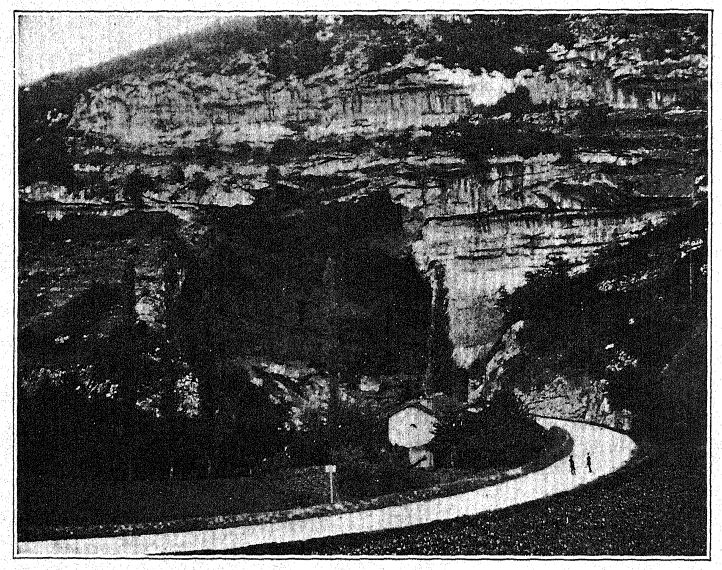
The Mas d’Azil section is as follows:
[ p. 461 ]
PREHISTORIC AND NEOLITHIC
IX. Iron implements, pottery of the Gauls. At the top Gallo-RGman remains, glass and glazed pottery.
VIII. Middle Neolithic and Age of Bronze; layer of pottery, polished stone implements, traces of copper and of bronze.
VII. Dawn of the Neolithic. Fauna includes the horse, urns-, stag, and wild boar. Chipped and polished flints, awls and polishers in bone; harpoons rare. Beginnings of pottery.
UPPER PALAEOLITHIC
VI. AZILIAN, red archasological layer, masses of peroxide of iron. Extremely moist climate. Broad flat harpoons of stag horn perforated at the base, numerous flattened and painted pebbles (galets), flints of degenerate Magdalenian form, especially small rounded planers and knife flakes, awls and polishers in bone. No trace of reindeer in the fire-hearths; stag abundant, also roe-deer and brown bear; wild boar, wild cattle, beaver, a variety of birds. No trace of polished stone implements. Interred in this layer, beneath the deposits of streaked cinders and quite undisturbed, two human skeletons were found, which Piette believed had been macerated wdth flints and then colored red with peroxide of iron.
V. Sterile finely stratified loam layer, a flood deposit of the River Arize.
IV. LATE MAGDALENIAN culture layer; twelve double-rowed harpoons made of reindeer horn, a few fashioned from stag horn ; numerous engravings and sculptures in bone. Remains of the reindeer rare in the hearths; those of the royal stag (Cervus elaphus) abundant.
III. A sterile flood deposit of the River Arize.
II. MIDDLE AND EARLY MAGDALENIAN culture layers, with barbed harpoons of reindeer horn; flint implements of early Magdalenian type, bone needles. Bones of the reindeer abundant.
I. Gravel deposits. Interspersed fire-hearths.
The total thickness of these culture deposits is 8.03 m., or 26 feet 4 inches. The AZILIAN type layer (VI) containing flat harpoons of stag horn and painted pebbles, intercalated between the deposits of the Reindeer Age and the Neolithic layers, is, on account of its stratigraphic position, the most interesting and instructive of all the sites representing this phase of transition; and Piette was fully justified in giving to the corresponding culture period the name of Azilian.2
The transformation of art and industry, indicated in the .Azilian culture layer, is as decided as that in the animal life. [ p. 462 ] We observe in this layer no trace of the animal engravings or sculptures which occur so abundantly in the late Magdalenian layer below ; the use of pigments is confined to the paintings of schematic or geometric figures on the flattened pebbles. There is no, suggestion of art in any of the bone implements, and the harpoons of stag horn are rudely fashioned ; this tj^e of harpoon appears to be the chief survivor of the rich variety of implements noted in the Magdalenian layer below. The stag horn harpoon, moreover, is fashioned with far less skill than the beautiful Magdalenian harpoons ; like them it has two rows of barbs, but they are not cut with the same dehcacy and exactness. As to the form of the new model, it is explained by the nature of the new material j the interior of the stag horn being composed of a spongy tissue, could not be utilized as could the harder and more compact interior of the reindeer horn; the craftsman, therefore, was obliged to fashion his harpoon out of the exterior of one side of the stag horn, and in consequence to make it flat.
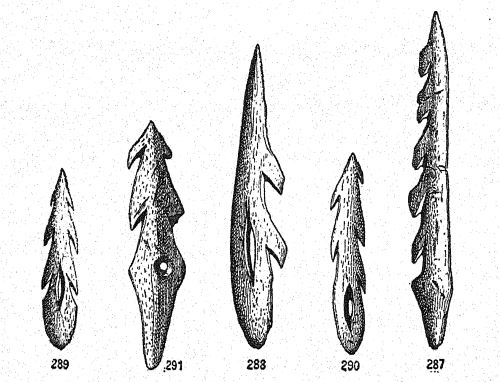
There are no bone needles, no javelins or sagaies; nor are there any of the beautifully carved weapons of bone. There is also a [ p. 463 ] reduction in the uses to which the split bones are put, such as the large lissoirs or polishers. The bone implements appear to be derived from an impoverished late Aurignacian stage ; the same is true of the flint implements, for we observe a return of the keeled scraper (grattoir caréné). There is also a return of certain types of graving tools and of the knife-like form of the flake ; even some of the small geometric types of flints resemble those of the Aurignacian levels.
The many shells of the moisture-loving snail Helix nemoralls, found in the fire-hearths of Mas d’Azil are proofs of the humidity of the climate, a fact confirmed by the contemporary flood deposits of the Arize. The frequent and heavy rains drove the last few representatives of the steppe fatma away to the north. These climatic conditions favored the formation of peat-bogs, so frequent to-day in the north of France, and also the growth of vast forests, inhabited by the stag, which extended over the whole country.
The pebbles of Mas d’Azil are painted on one side with peroxide of iron, a deposit of which is found in the neighborhood of the cave. The color, mixed in shells of Pecten, or in hollowed pebbles or on flat stones, was applied either with the finger or with a brush. The many enigmatic designs consist chiefly of parallel bands, rows of discs or points, bands with scalloped edges, cruciform designs, ladder-like patterns (scalariform) such as are found in the ‘Azilian’ engravings and paintings of the caverns, and imdulating lines. These graphic combinations resemble certain syllabic and alphabetic characters of the AEgean, Cypriote, Phoenician, and Greco-Latin inscriptions. However curious these resemblances may be, they are not sufficient to warrant any theory connecting the signs on the painted pebbles of the Azilians with the alphabetic characters of the oldest known systems of writing.3 Piette attempted to explain some of the exceedingly crude designs on these pebbles as a system of notation, others as pictographs and religious symbols, and some few as genuine alphabetical signs, and suggested that the cavern of Mas d’Azil was an Upper Palaeolithic school where reading, reckoning, [ p. 464 ] [ p. 465 ] writing, and the symbols of the sun were learned and taught. The very wide distribution of these symbolic pebbles and the painting of similar designs on the walls of the caverns certa.1nly prove that they had some religious or economic significance, which may be revealed by subsequent research.
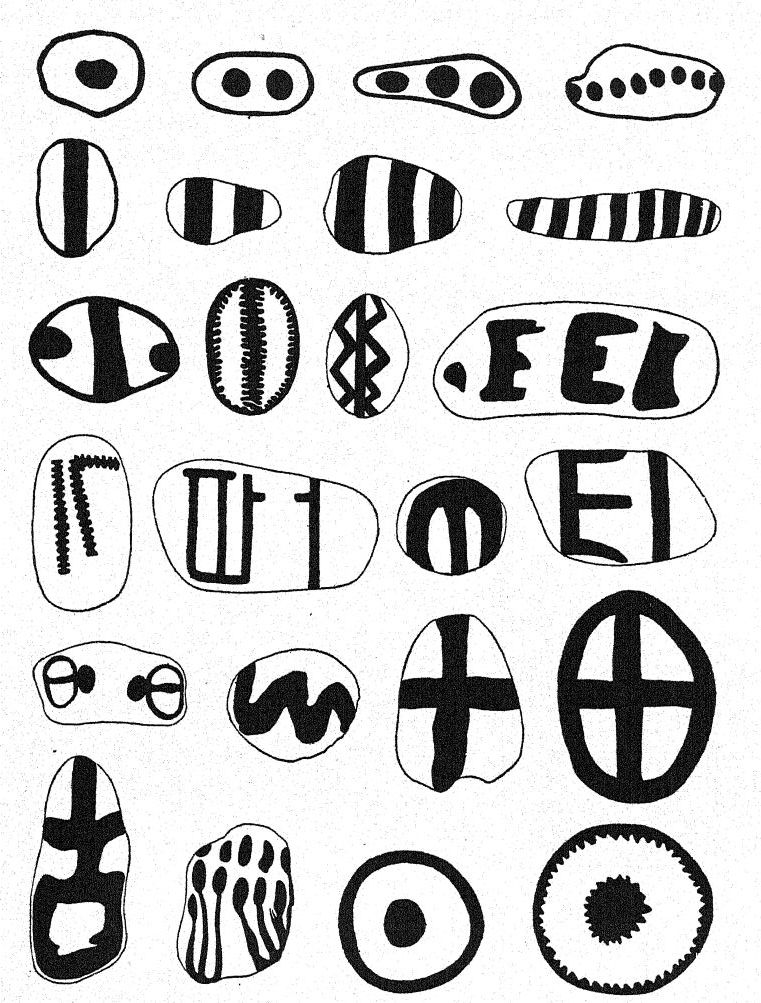
¶ The Taedenoisian Type Station
Turning from the region of the Pyrenees in Azilian times, we observe the region lying between the Seine and the Meuse in northern France as the scene of a contemporary industry. At the station of Fere-en-Tardenois, in the Department of the Aisne, is found an especially large number of the pygmy flints;4 these present various geometric forms, including the primitive triangular, as well as the rhomboidal, trapezoidal, and semicircular; together, they were designated by de Mortillet as Tardenoisian flints, and in 1896, in monographing this microlithic flint industry, he traced them throughout France, Belgium, England, Portugal, Spain, Italy, Germany, and Russia, also along the southern Mediterranean through Algiers, Tunis, Egypt, and eastward into Syria and even India.
These geometric flints were at first attributed to a primitive invasion which was supposed to have occurred at the beginning of Neolithic times; thus the Tardenoisian industry was considered as contemporaneous with that of the Campignian, which is early Neohthic. It was further observed that the topographical location of the stations closely followed the borders of ocean inlets, or of river courses, and when the food materials found in the hearths were compared, it appeared that these flints were used principally by fishermen or tribes subsisting upon fish. From an examination of the flints, it would appear that a very large number of them were adapted for insertion in small harpoons, or that those of grooved form might even have been used as fish-hooks. Thus the picture was drawn of a population of fishermen. The Tardenoisian, therefore, was for a long time regarded as contemporaneous with the early Neolithic [ p. 466 ] rather than with the close of Palaeolithic times, but as exploration proceeded it was formd that neither the remains of domestic animals nor any traces of pottery occur in any of these Tar denoisian deposits, which consequently have nothing in common with the true Neolithic culture.
The problem was finally solved in 1909, when the grotto of Valle near Gibaja, Santander, in northern Spain, was discovered by Breuil and Obermaier.5 Here was a classic Azilian deposit containing all the well-known Azilian types of bone implements, such as fine harpoons, carvings in deer horn, bone javelins, polishers of deer bone, flint flakes resembling those of the late Magdalenian, also nricrolithic flints of typical geometric Tardenoisian form. This discovery estabhshed the fact that the lower levels of the Tardenoisian industry were not really to be distinguished from the Azihan, for here beneath layers with painted pebbles and harpoons of Azilian style were harpoons with single and double rows of barbs of Magdalenian pattern, but cut in stag horn instead of reindeer horn.
The mammalian life in this true Azilian-Tardenoisian layer includes the chamois, roe-deer, wild boar, and urus, or wild cattle. In a layer just below, which represents the close of the Magdalenian industrial period, there are found, although rarely, remains of the reindeer, an animal hitherto unknown in this part of Spain, also the wild boar, the bison, the ibex, and the lynx. After this discovery it could no longer be questioned that the Azilian and Tardenoisian were contemporary.
As to the relation of these two industries, Breuil remarks6 that the prolongation of the Tardenoisian types of flints is observed in Italy and in Belgium, but neither the term ‘Tardenoisian’ nor the term ‘Azilian’ is sufl&ciently comprehensive to embrace the totality of these little industries, which will finally be distinguished clearly from each other. Of the two the Azilian represents the prolongation of an ancient period of industry, the progress of which was apparently from south to north, as we can trace the distribution of the characteristic flat haqjoons of deer horn from the Cantabrian Mountains and the Pyrenees, through [ p. 467 ] southern and central France, to Belgium, England, and the western coast of Scotland. The later industrial phase, the Tardenoisian, with its geometric trapeziform flints, originally appears along the southern Mediterranean in Tunis and to the eastward in the Crimea, while in France it represents a final phase of the Palaeolithic, closely approaching the period of the earliest Neolithic or pre-Campignian hearths common along the Danube and observed in the vicinity of Liege. Thus the most comprehensive term by which to designate the ensemble of these implements, in Europe at least, would be Azilian-Tardenoisian.
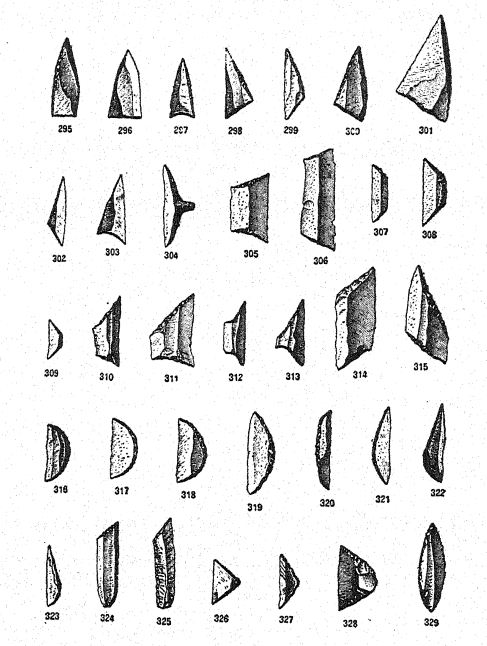
[ p. 468 ]
¶ Environment and Mammalian Life
It appears that the chief geographic change during this period was a subsidence of the northern coasts of Europe and an advance of the sea causing the circulation of warm oceanic currents and a more humid chmate favorable to reforestation.
To the north, in Belgium, the tundra fauna lingered during the extension of the early Tardenoisian industry, for here we still find remains of the reindeer, the arctic fox, and the arctic hare mingled in the fire-hearths with flints of Tardenoisian type. This, observes Obermaier, constitutes proof that the Tardenoisian, with the Azilian, must be placed at the very close of Postglacial time and with the final stage of Upper Palaeolithic industry.
To the south, in the region of Dordogne and the Pyrenees, the tundra fauna had entirely disappeared, as well as that of the steppes and of the alpine heights; the prevailing animal in the forests is the royal stag, adapted to forests of temperate type and associated with the Eurasiatic forest and meadow fauna which now dominated western Europe.
The only survivor of the great African-Asiatic fauna is the line which appears in the late Palaeolithic stations in the region near Pyrenees; the arctic wolverene also gives the fauna a glacial aspect, for, like the lion, it is never found in central western Europe after the close of Upper Palaeolithic times, other enemies of the herbivorous fauna were the wolf and the rown bear.
Besides the red deer, or stag, the forests at this time were fill ed with roe-deer. To the south in the Pyrenees the moose still survived, and to the north there were still found herds of reindeer which survived in central Europe as late as the twelfth’ century. Wild boars were numerous, and in the streams were found the beaver and the otter. In the forest borders and in the meadows hares and rabbits were abundant. Through the forests and meadows of southern France and along the borders of the Danube ranged the wild cattle (Bos primigenius). It would appear from [ p. 469 ] our limited knowledge of the life of Azilian-Tardenoisian times that bison were found chiefly in the northern parts of Europe. There is little direct evidence in regard to the wild horse, the remains of which do not occur in the hearths of Azilian times.
Our knowledge of the life of the Spanish peninsula at a period closely succeeding this is indirectly derived from the animal frescos in certain caverns of northern Spain, which have been attributed to the early Neolithic but are now referred rather to the late Palaeolithic. Here are found representations of the ibex, the stag, the fallow deer, the wild cattle, and also of the wild horses. This would indicate that wild horses were still roaming all over western Europe at the close of Upper Palaeolithic times. The presence of the moose in late Palaeolithic times at Alpera, on the high plateaus of Spain, has been determined ; this animal has also been found in the Pyrenees during the Azilian stage.’7
The great contrast between the mammalian life of Magdalenian and that of Azilian-Tardenoisian times is witnessed in the stations along the upper Danube, as described by Koken.8 In Hohlefels, Schmiechenfels, and Propstfels, associated with implements of the late Magdalenian industry, are found ten types of animals belonging to the forests and four characteristic of the forests and meadows, or fourteen species altogether. With these are mingled two alpine forms, the ibex and the alpine shrew; also two types of mammals belonging to the steppes, and no less than six mammals and birds from the tundras, namely, the reindeer, the arctic fox, the ermine, the arctic hare, the banded lemming, and the arctic ptarmigan.
In wide contrast to this assemblage of late Magdalenian life on the upper Danube, there appear in Azilian times along the shores of the middle Danube in the stations of Ofnet and of Istein the following characteristic forest forms ; Sus scrofa ferns (wild boar), Cervus elaphus (stag), Capreolus capreolus (roe-deer), Bos (?) primigenius (urus), Lepus (rabbit or hare), Ursus arctos (brown bear), Felis leo (Uon), Gulo luscus (common wolverene), Lynchus lynx (lynx), Vulpes (fox), Mustela martes (marten), [ p. 470 ] Castor fiber (European beaver), Mus (field-mouse), Turdus (thrush). It thus appears that the alpine, the steppe, and the tundra faunae had entirely disappeared from this region.
¶ Origin and Distribution of the Azilian-Tardenoisian Industry
This industry represents the last stage of the Old Stone Age. The decline in the art of fashioning flints, begun in Magdalenian times, appears to continue in the Azilian-Tardenoisian. As to the tiny symmetrical flints which are characteristic of this period, among the microliths of almost all the late Magdalenian stations pre-Tardenoisian forms are found which may be regarded as prototypes of the geometric Tardenoisian flints ;9 this represents a new fashion established in flint-making under influences coming from the south.
There was also a natural or local Azilian evolution from the Magdalenian types and technique. In general the flint implements which had so long prevailed in western Europe become smaller in diameter and more carelessly retouched, showing marked deterioration even from the late Magdalenian stages. For the preparation of hides and the fashioning of bone we discover unsymmetrical planing tools (grattoirs), also small, wellformed oval scrapers (racloirs), and microlithic scrapers. Borers (perçoirs) with oblique ends and gravers (burins) made of small flakes are the types of implements which most frequently occur, but the great variety of borers, so characteristic of the Aurignacian and the Magdalenian industries, had entirely disappeared in Azilian times.
The marks of industrial degeneration are also conspicuous in the bone implements, which show a very great deterioration in number and quality as compared with the Magdalenian, and which are principally confined to three types — the harpoons, the awls (poinçons), and the smoothers (lissoirs) , together with very small bone borers (perçoirs). The distinctive feature of the Azilian bone industry is the flat harpoon of stag horn ; it is known that the use of stags’ antlers for fashioning harpoons began in [ p. 471 ] the late Magdalenian, when most of them were still being fashioned from reindeer horn. These flat Azilian harpoons succeed the type of the double-rowed, cylindrical harpoons of the late Magdalenian, and are found mainly where the rivers, lakes, or pools offered favorable conditions for fishing. Thus the Azilian bone-harpoon industry, like the Tardenoisian microlithic flint industry, was largely pursued by fisherfolk.
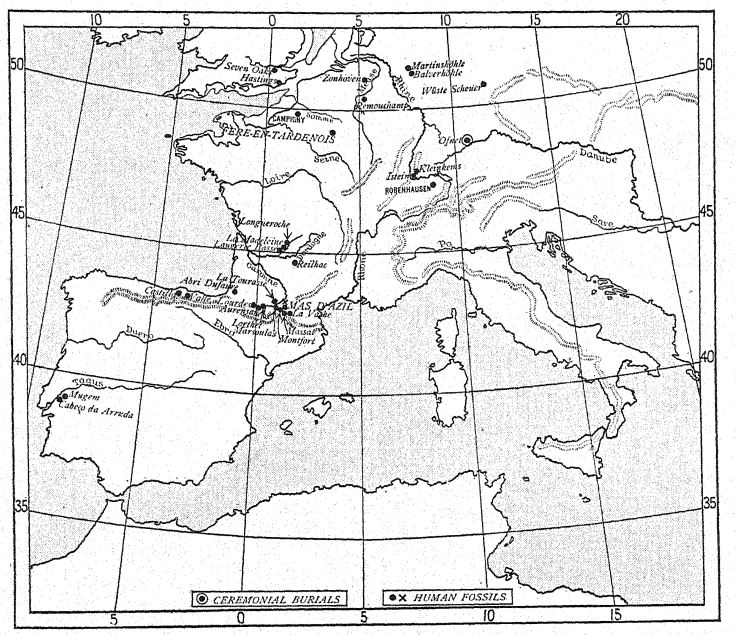
We may imagine that the gradual disappearance of the reindeer, an animal much more easily pursued and killed than the stag, was one of the causes of the substitution of the various arts of fishing for those of hunting.
It is to the excessively small or microlithic flints that the name Tardenoisian especially applies, and it is the vast multiplication of these microliths and their wide distribution over the [ p. 472 ] whole area of the Mediterranean and of western Europe which constitutes the most distinctive feature of this industrial stage.'® The triangular flint (Fig. 249) is certainly the most ancient Tardenoisian type. It occurs in the Azilian stations of the Cantabrian Mountains and of the Pyrenees, accompanied by the painted pebbles and with other flints of Azilian type, but without the graving-tools ; to the east it is found in the stations of Savoy; and along the Danube it occurs at Ofnet, associated with remains of the lion and the moose, also with ornamental necklaces composed of the perforated teeth of the deer, identical with those found in the type station of Mas d’Azil in the Pyrenees. To the north this typical early Azilian culture extends to Istein, in Baden, where it includes the microlithic flint flakes, the gravers, and the little round scrapers associated here also with the stag and the prehistoric forest and meadow fauna of western Europe. Exactly the same stage of industrial development occurs in the grotto of Hohlefels, near Nuremberg, and in the shelter station of Sous Sac, Ain. We invariably find proofs of the variety of these pygmy flints as well as of their continuity from one station to another. All these facts compel us to assign a very long period of time to the spread of these industrial types.
The question which arises as to the sources of this special Tardenoisian industry again finds archaeologists divided. Schmidt inclines to the autochthonous theory and regards the microHthic flint industry as an outgrowth of tendencies already well developed in the Magdalenian. Breuil, on the other hand," dwells strongly on the evidence for circum-Mediterranean sources. In putting the questions. Who were the Azilians ? Whence did they come? What were their ancestors? he is disposed to give the answer already quoted, that, whichever industry is examined, we are always obliged to look toward the south, toward some point along the Mediterranean, for the origin of these microlithic flints. In Italy, which he believes to have remained in an Aurignacian industrial stage throughout all the long period of Magdalenian time, he finds at Mentone a layer overlying the Aurignacian and containing small flints recalling the geometric [ p. 473 ] forms of the Azilian, as well as a multitude of the small round scrapers (racloirs) characteristic of Azilian times. The upper layers at Mentone on the Riviera are paralleled by those observed near Otranto, in Sicily. It is certain, he continues, that [ p. 474 ] all around the Mediterranean there was a number of distinct centres where microlithic implements of geometric form appeared, and where the accompanying industries, in different stages of development, were related to an Upper Palaeolithic culture consisting of a continuous Aurignacian type.
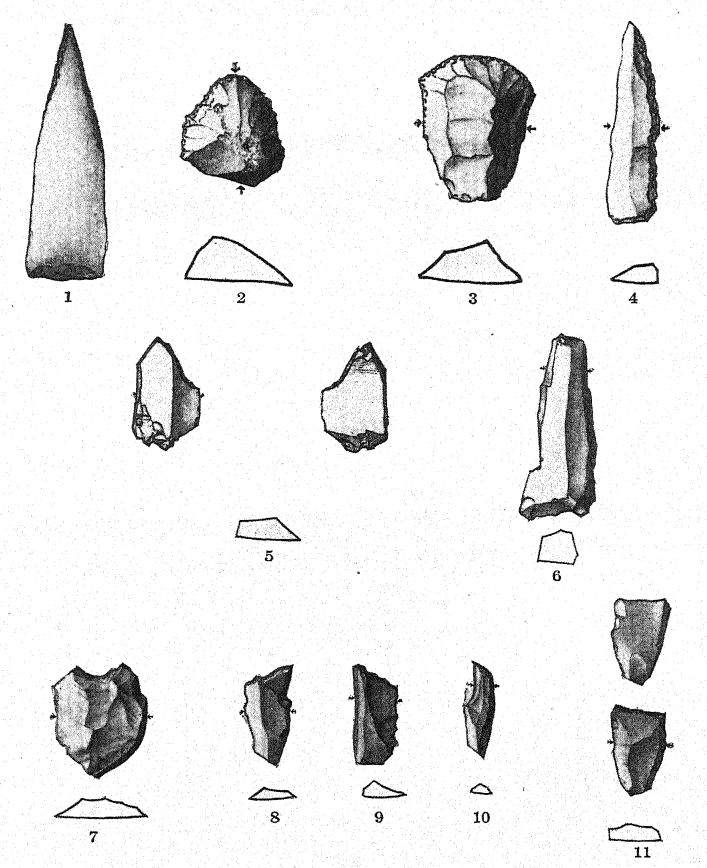

The labors of de Morgan, Capitan, and others have thrown great hght on the Palaeolithic of Tunis, where a flint culture was developed only slightly different from that of the Azilian of Valle, Santander, of the Mas d’Azil, Ariege, and of Bobache, Drdme. A resemblance is also found in Portugal; and southern Spain, despite its poverty of typical implements, shows a similar evolution. Near Salamanca, northwest of Madrid, Spain, the grottos contain schematic figures and colored pebbles resembling the Azilian. In Portugal the hearths of Mugem and Cabego da Arruda are distinguished by their triangular microliths and are undoubtedly Pre-NeoHthic, because there is neither pottery nor any trace of domesticated animals, excepting, possibly, the dog.
To the north of Europe the discoveries in Belgium have especial importance, for typical Azilian implements, including small round west coast of Scot- scrapers, lateral gravers, elongated triangular microliths, and knife flakes are found associated with the remains of the reindeer in the grotto of Remouchamp and at Zonhoven. It appears in Belgium, as in Italy, that the use of the Tardenoisian microhthic flint types is prolonged into a later time than that of the typical Azilian flint implements — the scrapers, gravers, borers, and knife flakes — which, as we have seen, appear at the end of the true Magdalenian.
On the other side of the English Channel we again find these .lint Iways unmingled vdth pottery and usually distributed alone sea or river shores. The best-known stations are those [ p. 475 ] of Hastings, directly across the Channel opposite Boulogne, and of Seven Oaks, near London ; in Settle, Yorkshire, is the Victoria Cave station. To the north, in Scotland, four Azilian stations have been discovered around Oban, on the western coast near the head of the Firth of Lome, while Azilian harpoons have also been found on the Isle of Oronsay, at its entrance.
Thus the spread of the very small Tardenoisian flint implements in the final stages of the Palaeolithic precedes the southern advent of the Neolithic.
In Germany only six Azilian-Tardenoisian stations have thus far been discovered: two to the east of Düsseldorf, one in the neighborhood of Weimar, two on the headwaters of the Rhine, near Basle, and, by far the most important, the large and small grottos of Ofnet, on a small tributary of the Danube northwest of Munich. This last is exceptionally important because it is the oifly station where skeletons have been found buried with Azilian-Tardenoisian flints, thereby enabling us positively to determine the contemporary human races.
¶ Burials in Azilian-Tardenoisian Times
The strange interment which gives Ofnet its distinction belongs to the period of Azilian-Tardenoisian industry.’12 This conclusion is not weakened by the absence of Azilian harpoons or painted pebbles, because at tins time the cave of Ofnet served its frequenters only as a place of burial ; there are no hearths or flint workshops to indicate continued residence, as during earlier Upper Palaeolithic times.
This great ceremonial burial seems to afford the only positive evidence to be found in all western Europe of the kind of people who were pursuing the Azilian industry. The larger Ofnet grotto opens toward the southwest and has a length of 39 feet and a width of 36 feet. It was first entered in early Aurignacian times and shows successive layers of Aurignacian, early Solu trean, and late Magdalenian cultures, above which lies a thick deposit of the Azilian-Tardenoisian, in which is found the most remarkable interment of all Palaeolithic times.
[ p. 476 ]
This is a ceremonial burial of thirty-three skulls of people belonging to two distinct races; respectively, brachycephalic and dolichocephahc, and certainly not related in any way to the Crô-Magnon race. In one group twenty-seven skulls were found embedded in ochre and arranged in a sort of nest, with the faces all looking westward. As the skulls in the centre were more closely pressed together and crushed than those on the outside, it seems probable that these skulls were added one by one from time to time, those on the outside being the most recent additions. About a yard distant a similar nest was found, containing six more skulls embedded and arranged in exactly the same manner. The interment probably took place shortly after death and certainly before the separate bones had been disintegrated by decomposition, for not only the lower jaw but a number of the neck vertebrae were found with each skull. The heads had [ p. 477 ] been severed from the necks by a sharp flint, the marks of which are plainly visible on some of the vertebrae.
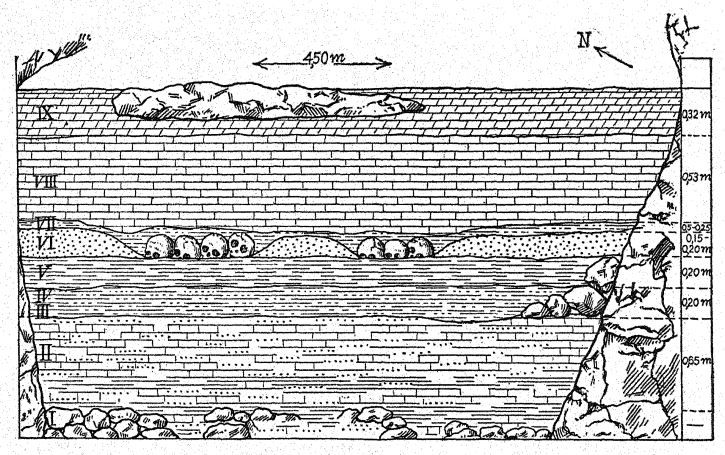
It is noteworthy that most of these skulls are those of women and young children, there being only four adult male skulls. On his account some advance the theory of cannibalism; others that, being taken captive by a tribe of enemies, these unfortunate people were offered in sacrifice, in which case decapitation was the means of death. But, then, how explain the abundant ornaments of stag teeth and snail shells (Helix nemoralis) with which the skulls of the women and little children were decorated, and the treasured implements of flint with which all save one of the men and a few of the women and children were provided?
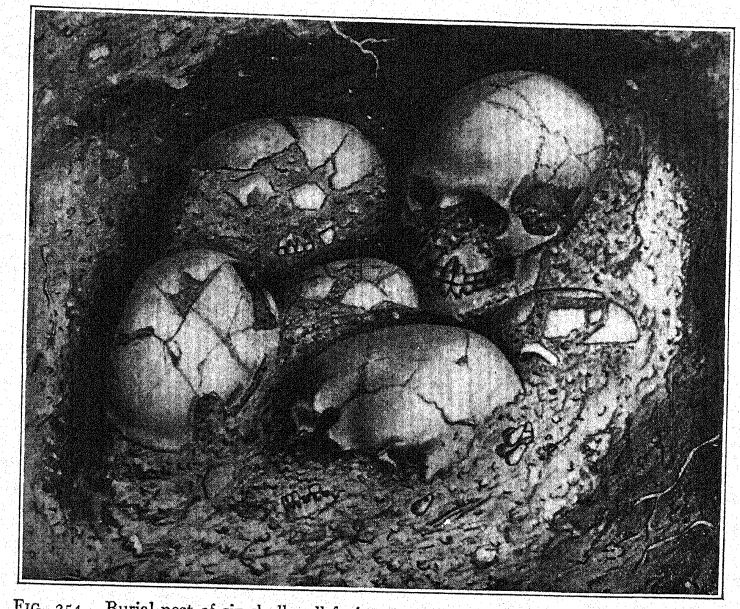
There are precedents for all these singular features of the Ofnet interment in other Upper Palaeolithic burials, namely, the embedding in ochre, the offerings of ornaments of teeth and of [ p. 478 ] [ p. 479 ] shells, the separate interment of the skull— all these were customs more or less characteristic of the Upper Palaeolithic, but never observed in Neolithic times.
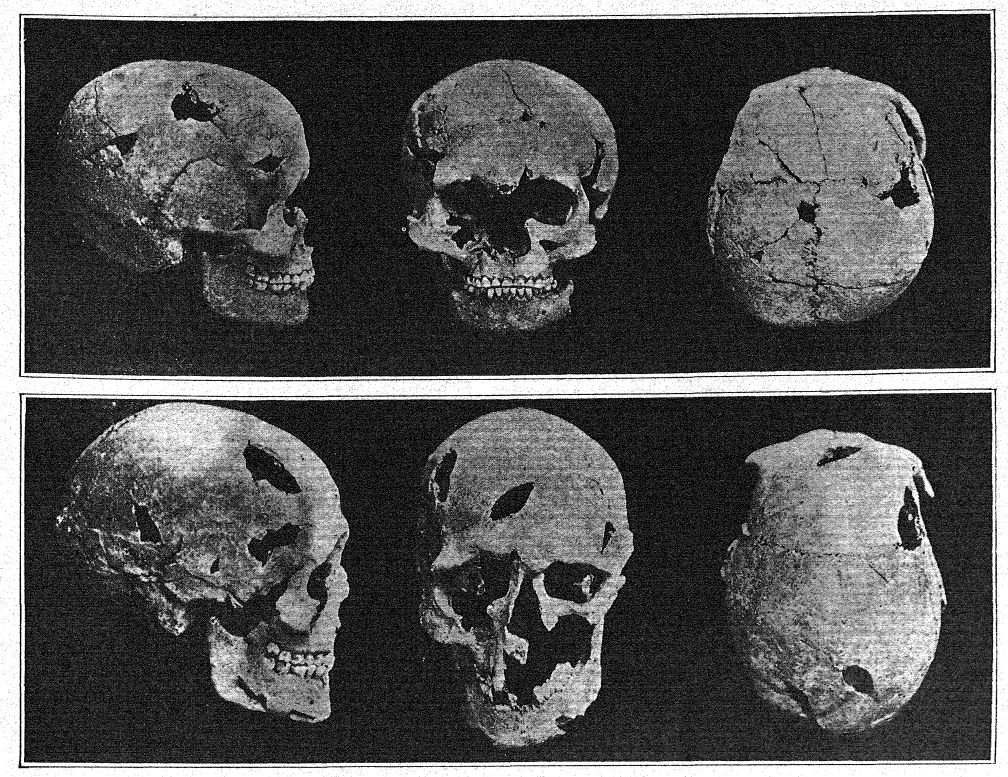
It will be recalled that the custom of burying the entire body, as well as that of embedding the body in ochre, is first observed among the late Neanderthals and obtained throughout the entire Upper Palaeolithic from the Aurignacian burials of Grimaldi to the Azilian of Mas d’Azil. No other case, however, is known of the westward turning of the face: in most of the Upper Palaeolithic burials the face of the departed looks toward the opening of the grotto; but, although the grotto of Ofnet opens toward the southwest, the skulls, without exception, were facing exactly to the west and looking toward the wall rather than toward the entrance of the cavern.
¶ The New Broad-Headed and Narrow-Headed Races of Ofnet
The burials at Ofnet are the first observed in western Europe which present a mingling of races. This in itself is a fact of great interest ; it is a prelude to what characterizes all the populations of western Europe at the present time, namely, the presence of races widely separated in origin and in anatomical structure, but closely united by similar customs, industries, and beliefs.
A second fact of even greater importance is the proof of the arrival in western Europe toward the close of Palaeolithic times of two entirely new human stocks; one broad-headed, resembling the modern Alpine or Celtic type ; the other narrowheaded, resembling the modern ‘Mediterranean’ type of Sergi. Beside these pure types there are several blended forms which are intermediate or mesaticephalic.
Of the eight brachycephalic heads, six are those of children ; the twm adult brachycephalic crania belong to young women and are, therefore, not quite so characteristic as male skulls would be, for in general racial type is more strongly marked in [ p. 480 ] men than in women ; the remaining skulls are either of a blended form or purely dolichocephalic.
The relationship of the broad-headed race to other prehistoric and existing broad-headed races of western Europe is also a matter of very great interest. The Ofnet brachycephals are regarded by Schliz13 as closely similar to the type skull of the so-called Crenelle race, which, in turn, is closely similar to the Furfooz type. Thus the cephalic index of one (Fig. 255) of these broad, flattened skulls of Ofnet is 83.33 per cent; the face is relatively narrow, the zygomatic index being low — 76.34 per cent; the brain capacity of the female skulls does not exceed 1,320 c. cm. The skull is further described as small, smooth, and delicately modelled, with a correspondingly feeble dentition, the teeth being small ; the processes of muscular attachment are slightly developed, all of which characters indicate that the skull belonged to a woman about twenty-five years of age. The forehead is low, broad, and prominent. It is altogether typically parallel to the ‘skull of Crenelle,’ as well as to the female ‘skull of Auvernier’ described by Kollmann. The peculiarity of this broad-headed race, like that of Crenelle and of Furfooz, is that, while the forehead is of only moderate breadth, the posterior part of the skull is extremely broad. The broad-headed people of Ofnet are thus definitely considered by Schliz14 as members of the Furfooz-Crenelle race.
The narrow-headed race of the Ofnet burials is distinct in every respect and presents resemblances to the branch of the ‘Mediterranean’ race found in the foreground of the Alpine regions to-day, in which the head is of a pear-shaped type. The best preserved of these dolichocephalic skulls (Fig. 255) presents an index of 70.50 per cent, with a brain capacity in the male of 1,500 c. cm., while the smallest brain capacity is that found in one of the female skulls with 1,100 c. cm. Among the five adult purely dolichocephalic skulls the face is not in the least of the broad or disharmonic Crô-Magnon type, but is in proportion with the cranium, and is thus truly harmonic. The resemblance of this narrow-headed Ofnet skull to that of the Brünn race. [ p. 481 ] which we have described as occurring in Moravia in Solutrean times, is only partial, and Schliz concludes that among the narrowheaded people of Ofnet we have a form of dolichocephaly which is not identical with any of the known early dolichocephalic forms of western Europe, but which pursues an independent line of development similar to the narrow-headed races in the borders of the Alpine region of the present day. Thus this head type, of a uniform elliptic contour, seems to have become a stable racial element of the Alpine population, since we meet it again in later prehistoric times in the region of the southern and western foreground of the Alps. Among the children’s skulls, two are of the narrow-headed, pear-shaped type similar to the Alpine dolichocephals of to-day, that is, with a narrow forehead and very broad posterior portions of the skull.
¶ Central Origin of the Broad-Headed (Alpine?) Races
The affinity of the broad-headed Az;ilian-Tardenoisian tribes of the Danube to those found in the Upper Palaeolithic of northwestern Europe seems to be clearly established. The latter are sometimes known as the GreneUe race and sometimes as the Furfooz race. Boule15 observes in regard to the skeletal remains of Grenelle which were found in the alluvium near Paris, in 1870, that it is quite impossible now, forty years after their discovery, to demonstrate their geologic antiquity. This is not the case with the Furfooz broad-heads, the age of which we regard as well established, but since the head type appears to be the same in both cases, we may speak of this race as the Furfooz-Grenelle.
In a cave near Furfooz, in the valley of the Lesse, Belgium, sixteen skeletons were discovered by Dupont in 1867. With the bones were found implements of reindeer horn and remains of the late Pleistocene fauna of northern Europe. The reindeer and the tundra fauna of Belgium were contemporaneous with the early Tardenoisian culture and with the stag and forest fauna [ p. 482 ] of southern France, so that the skeletons of Furfooz may safely be referred to Azilian-Tardenoisian times.
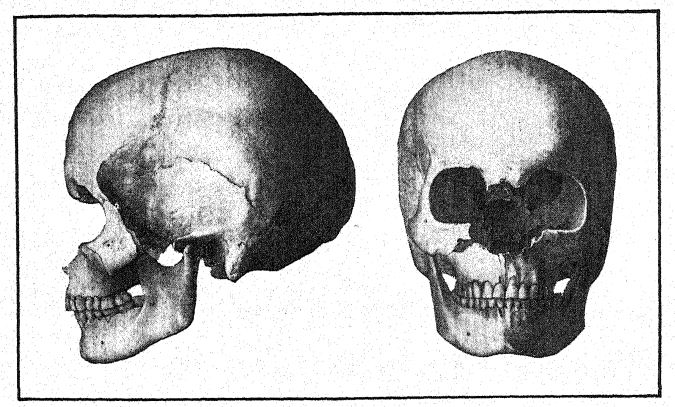
Only two of the Furfooz skulls were preserved in good shape ; they are of brachycephalic or sub-brachycephalic form, and, following [ p. 483 ] the suggestion of de Quatrefages and Hamy, these skulls have been spoken of as belonging to the ‘brachycephahc Furfooz race.’ The men of this race may certainly be regarded as belonging to Upper Palaeolithic times, whereas the brachycephalic [ p. 484 ] race found at Crenelle, near Paris, is probably Neolithic. This by no means prevents the Furfooz and the Crenelle types belonging to the same general brachycephalic race; it is altogether probable that they do, and that with them may be included the Ofnet broad-heads.
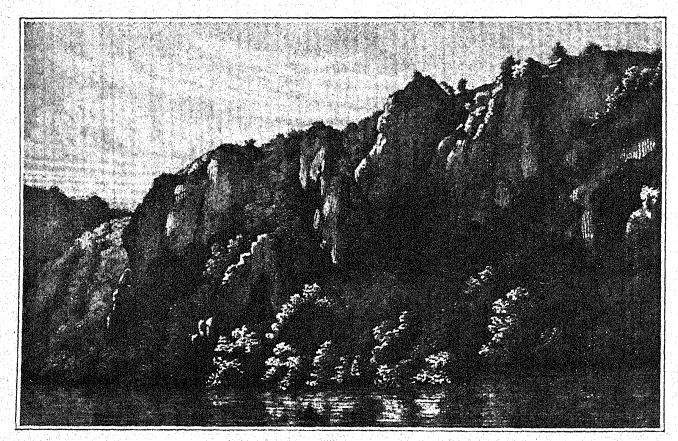
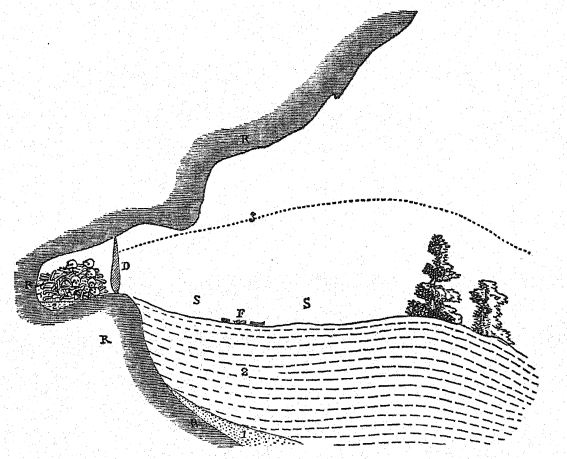
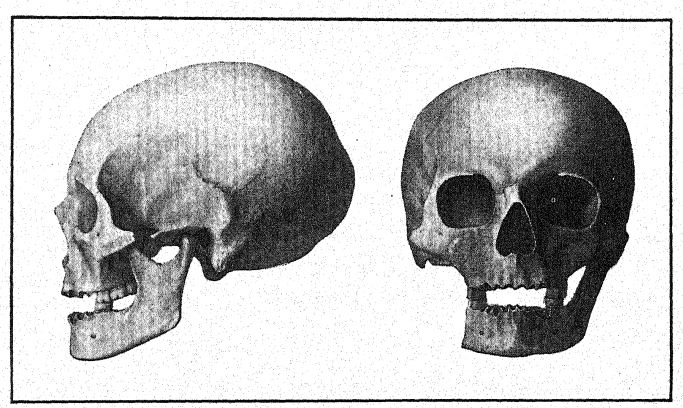
There are several opinions regarding the geographic centres from which these broad-heads entered Europe ; it is generally believed that they came from the high plateaus of central Asia. By Ciuffrida-Ruggeri the Furfooz race is identified with the existing, broad-headed Alpine race (Homo sapiens alpinus), and is mistakenly adduced as proof that the Alpine race originated in Europe and is not in any way related to the Mongolian races oi. central Asia. A more conservative view17 is that the recent European broad-headed types commonly included under the Alpine race cannot yet be traced back to the Furfooz-Crenelle ancestors, because their connection is too problematical. Schliz, [ p. 485 ] on the other hand, considers that the Furfooz-Grenelle race survived in northwestern Europe and corresponds with that which became the builders of the megalithic dolmens of Neolithic times, the latter being but slightly modified descendants of the original Furfooz race ; he believes, moreover, that these broad-headed peoples first occupied central Europe and then extended to western Europe, where they correspond to the Alpine race, at least in part; that they also migrated to the north and were the basis of the broad-headed races now found in Holland and Denmark.
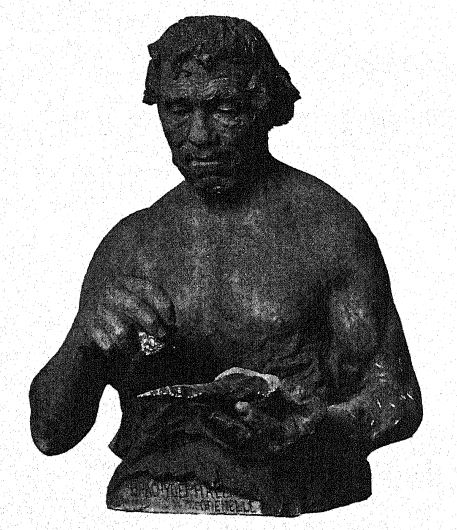
¶ Southern Origin of the Narrow-Headed (Mediterranean?) Races
While it seems probable that the broad-heads represent a central migration from Eurasia, evidence of an industrial and cultural character indicates that the narrow-heads came from the south ; this is seen both in the south Mediterranean origin of the Tardenoisian flint industry and in the new schematic influences on the decadent art of Upper Palaeolithic times.
It seems, observes Breuil, as if the schematic influences in art during Upper Palaeolithic times always extend from the south toward the north ; they predominate entirely in the painted rocks of Andalusia, in the Pyrenees, and in Dordogne. In the grotto of Marsoulas, Haute-Garonne, the Azilian motifs are clearly superposed upon the Magdalenian polychromes. This purely schematic phase, which abruptly follows the figure art of middle Magdalenian times, first made itself felt in the late Magdalenian. There was a sudden loss of realism which does not indicate afifiliation but rather the infiltration of strange elements from the south ; the precursors of the destructive invasion of the Azilian-Tardenoisian tribes who were, driven from their Mediterranean homes by the westward advance of the conquering Neolithic races. We imagine18 that in southern Spain the-'., dwelt in Upper Palaeolithic times a population differing froin die Magdalenians of France and of the Cantabrian Mountains in their lower artistic tastes. It would therefore appear that the [ p. 486 ] schematic art had its home toward the south of the peninsula of Spain about the time of the invasion of the Azilian culture in France.
¶ Northern Origin of the Baltic (Teutonic?) Races
For the first time the retreat of the Scandinavian ice-fields and the less severe climate permitted a northern migration route along the shores of the Baltic. This is the first known migration of any tribes along this route, which throughout aE glacial times had been blocked by the vicinity of the SGandinavian and Baltic ice-fields, but which was now opened by the approach of the more genial climate which succeeded the long Postglacial Stage. Whether this Baltic invasion was the advance wave of a northern long-headed Teutonic race is whoUy a matter of conjecture.
“Other peoples,” observes Breuil,19 “known at present only from their industries, were advancing toward the close of the Upper PalaeoUthic along the northern and southern shores of the Baltic and persisted for an appreciable time before the arrival of the tribes introducing the early NeoEthic Campignian culture which accumulated in the kitchen-middens along the same shores. Like the southern races of Azilian-Tardenoisian times, these northerly tribes were truly Pre-NeoHthic, ignorant both of agriculture and of pottery; they brought with them no domesticated animals excepting the dog, which is known at Mugem, at Tourasse, and at Oban, in northwestern Scotland. In the use of bone harpoons of elegant form and in the taste displayed in fine decorations engraved upon bone, these tribes suggest the culture of the Magdalenians, but a close examination shows that it coiEd not have been derived from the Magdalenian type. The community of style with the painted and engraved figures found in western Siberia and in the central Ural region and north of the Altai Mountains denotes rather an Asiatic and Siberian origin.
“The decorative designs of these Baltic peoples were very different from those of the Crô-Magnons in Magdalenian times, [ p. 487 ] and are not schematic ; the conception of the animal figures, although naturalistic, is as crude as that of the early Aurignacian figures, and is far inferior to that of the Magdalenian stage.” “It is probable,” continues Breuil, “ that in these northerly regions the closing cultures of the Upper Palaeolithic developed along more or less parallel lines with those observed in the south in giving rise to ethnographic elements which travelled along the littoral regions of the northern seas.”
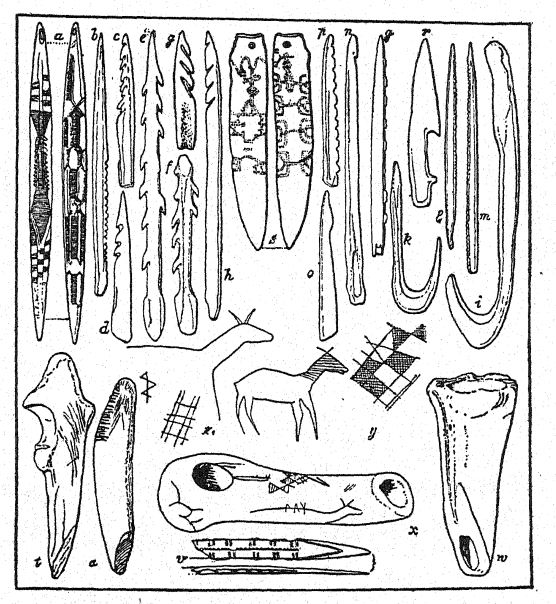
This race and culture is described by Obermaier20 as follows: When primitive man took possession of Denmark the seacoast was so remote that he could also reach southern Scandinavia. The station of Maglemose in the ‘Great Moor,’ discovered and described by F. L. Sarauw, of Copenhagen, in 1900, is [ p. 488 ] near the harbor of MuUerup on the western coast of Zealand and not far from the shore of an ancient freshwater lake formation. These people were lake-dwellers, living perhaps on rafts but not on dwellings supported by piles. From these rafts it is supposed the implements dropped into the lake. The 881 flint implements found here include scrapers, borers, cleavers, and knives, as well as microlithic flints. They show no trace of the Neohthic art of polishing, merely suggesting certain chipped styles observed in the ‘kjöddenmoddings.’ (See Figs. 263, 264, and 265.) The influence of the Palaeolithic is much stronger, especially in the case of the microlithic Tardenoisian types. In the industrial culture of Maglemose, however, far more important than stone are implements of horn and bone. These the Maglemose folk obtained from the wild ox, moose, stag, and roedeer, fashioning them into tools of various types, some of which are shown in Fig. 261. Many of these tools are ornamented with conventional designs or very crude animal outlines on one or both surfaces.
The forests of this time consisted of the characteristic northern flora including numerous evergreens, the birch, aspen, hazel, and elm, but without any trace of the oak. There is absolutely no trace of pottery in the Maglemose deposits. Of great interest is the fact that skeletal remains of the domestic dog are found here.
The Maglemose culture of the Baltic region is regarded as contemporary with the Azilian and Tardenoisian in the south. It contains t3/pes, not of flint but of bone, which are prophetic of the Neolithic. Traces of this culture have been found throughout northern Germany, in Denmark, and in southern Sweden, as well as to the east and in the Baltic provinces. Although no human remains have as yet been discovered, it is highly probable that these people belonged to the northern Teutonic races.
[ p. 489 ]
¶ Conclusion as to the Relationships of the Palaeolithic Races
Thus in southern, central, and northern Europe the close of Upper Palaeohthic times is marked by the invasion of new Eurasiatic races, all in a Pre-Neolithic stage of industry and art. It is not improbable that these races were advance waves from the same geographic regions as the Neolithic tribes which followed them.
From the earliest Palaeolithic to Neolithic times it does not appear that western Europe was ever a centre of human evolution in the sense that it gave rise to a single new species of man. The main racial evolution and the earlier and later branches of the human family were established in the east and successively found their way westward ; nor is there at present any ground for believing that any very prolonged evolution or transformation of human types occurred in western Europe.
We should regard as wholly unproved the notion that either of these Palaeolithic races of western Europe gave rise to others which succeeded them in geologic time ; the only sequence of this sort to which some degree of probability may be attached is that the Heidelberg race was ancestral to the Neanderthal race.
In most instances, such races as the Piltdown, the Crô-Magnon, the Brünn, the Furfooz-GreneUe, and the Mediterranean arrived fully formed, with all their mental and physical attributes and tendencies very distinctly developed. There is some evidence, but not of a very conclusive kind, that the modification of certain of these races in western Europe was partly in the nature of a decline ; this was apparently the case both with the Neanderthals and with the Crô-Magnons.
We may therefore imagine that the family tree or lines of descent of the races of the Old Stone Age consisted of a number of entirely separate branches, which had been completely formed in the great Eurasiatic continent, a land mass infinitely larger and more capable of producing a variety of races than the diminutive peninsular area of western Europe.
[ p. 490 ]
A review of these races in descending order, in respect to stature, the cephalic index, and brain capacity, is presented in the following table:
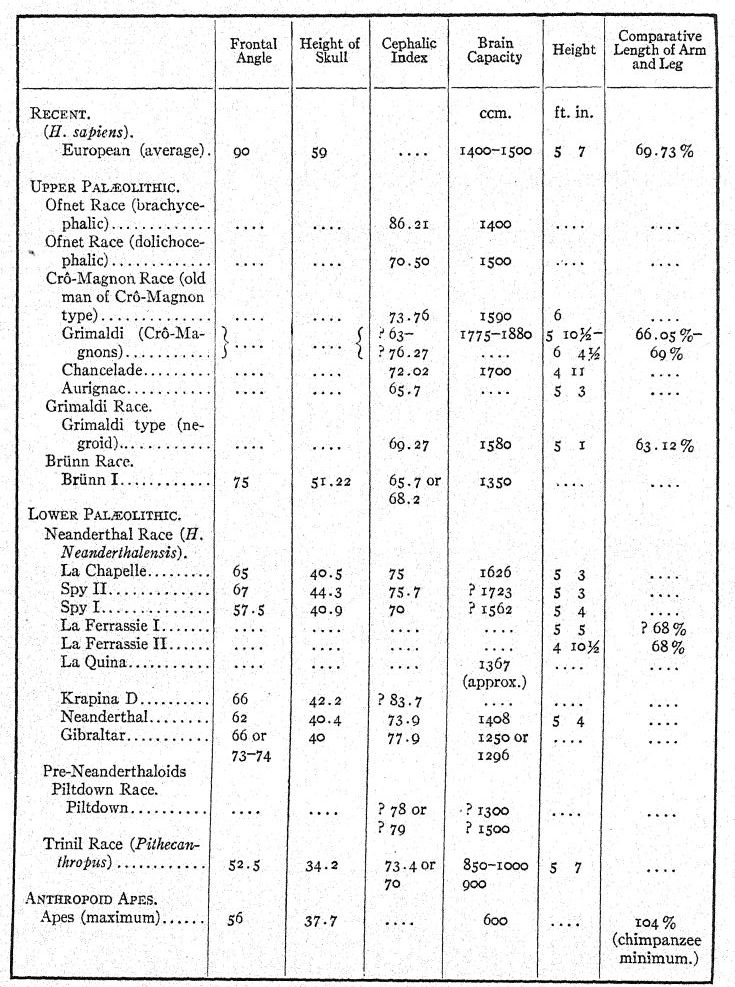
The chief authorities for these measurements are Schwalbe, Dubois, Keith, Smith Woodward, Boule, Sollas, Sera, Klaatsch, Fraipont, Makowsky, Verneau, Testut, and Broca.
[ p. 491 ]
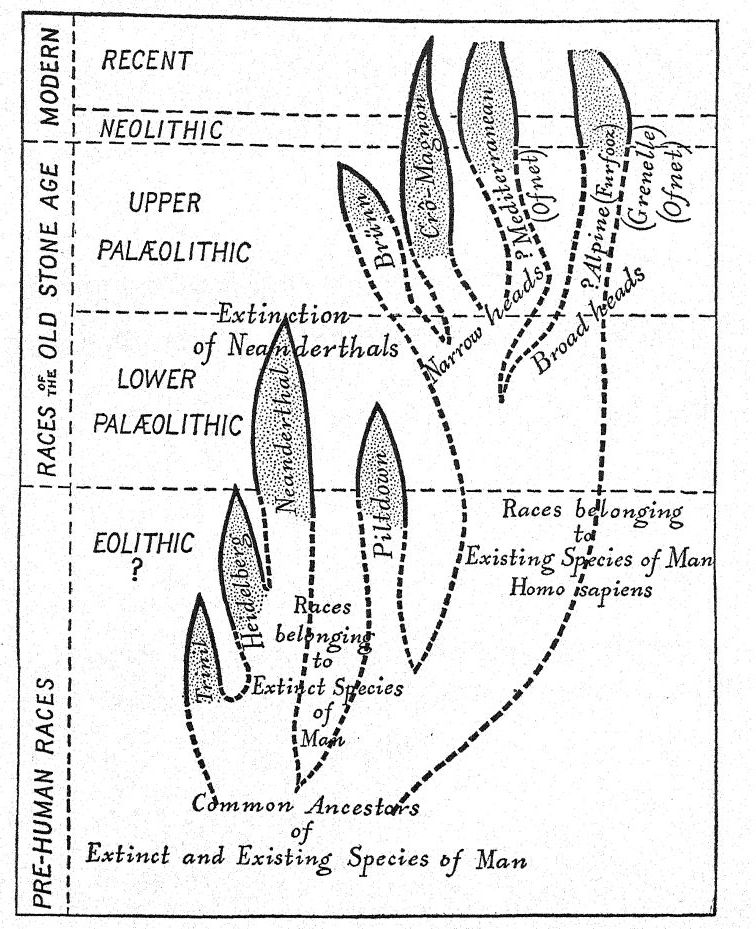
[ p. 492 ]
The migration routes of invasion of the successive Lower Palaeohthic races — the Piltdown, the Heidelberg, and the Neanderthal — are entirely unknown ; we can only infer from the wide distribution of the Chellean and Acheulean cultures to the south, along the northern African coast, as well as to the east, that these races may have had a southerly or circum-Mediterranean origin. This does not mean.that either of these Lower Palaeolithic races were of negroid or Ethiopian affinity, because the Neanderthals show absolutely no negroid characters. In fact, throughout all Palaeolithic time the soHtary instance of the two Grimaldi skeletons furnishes the sole anatomical evidence we possess of the entrance of a negroid people into Europe, which contrasts widely with the overwhelming evidence of the dominance in western Europe first of the non-negroid Neanderthals, and then of the Crô-Magnons who probably belonged to the Caucasian stock.
The evidence as to the sources and migrations of the Upper Paleolithic races is also indirect. The theory of the Crô-Magnons entering Europe by the southerly or Mediterranean route we have seen to rest upon purely cultural or, industrial grounds, namely, the spread of the Aurignacian industry around the Mediterranean shores. On the other hand, the succeeding culture, the Solutrean, and the succeeding race to enter Europe, the Brünn, both appear to be of central or of direct easterly origin. It is only toward the close of the Upper Palaeolithic that another southerly or Mediterranean invasion occurs, bringing in the microlithic Tardenoisian culture, which, although anatomical evidence is wanting, would appear to be an advance wave of the great invasion of the true ‘Mediterranean’ race. During the Upper Palaeolithic Epoch another invasion apparently occurs from the east along the central migration route, namely, that of die broad-headed Furfooz-Grenelle races.
Thus in surveying the whole period of the Old Stone Age we find that there is some evidence for the theory of an alternation southerly, of easterly, and finally of northeasterly invasions bringing in new industries and ideas.
[ p. 493 ]
¶ Transition to the Neolithic. The Campignian. The Robenhausian
Apart from the special and somewhat debated question of the place of the Campignian culture in the prehistory of Europe we may close our survey of the Upper Palaeolithic by pointing out some of its contrasts with the Neolithic.
The arrival of the Neolithic cultures and industries in western Europe marks one of the most profound changes in all prehistory and introduces us to a new period which must be treated in an entirely different historic spirit. This new era began between 7,000 to 10,000 years ago, or with the close of the Daun stage, the last geologic feature of Postglacial times.
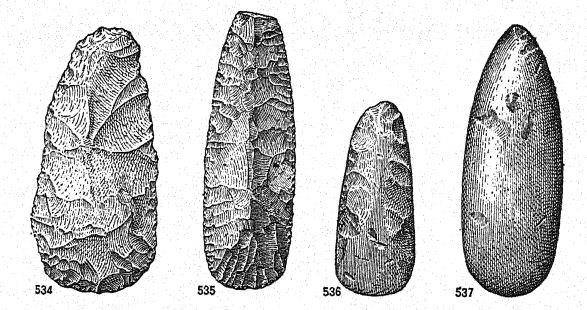

There are two theories regarding the close of Upper Palaeolithic and the beginning of Neolithic times. The older theory , which still has some adherents, is that the Upper Palaeolithic races and industries suddenly gave way before the artival of new and superior races bringing in the Neolithic culture. The newer theory is that there are evidences of gradual transfusions [ p. 494 ] from the Upper Palaeolithic into the Neolithic cultures and that these are found in some of the oldest Neolithic sites.
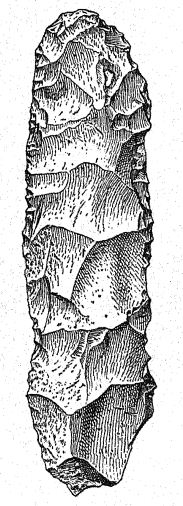
In 1898 there appeared an article^^ by Philippe Salmon, d’Ault du Mesnil, and Capitan, entitled, “Le Campignien,” defending the theory of an early and transitional Neolithic stage, the Campignian.22 The type station of this early culture was pointed out by Salmon in 1886 ; it lies a little more than a mile northwest of the village of Slangy, on the River Bresle, on a site well placed for natural defense. The remains of the hut-dwellings of this camp and of various industrial objects appear to indicate that this station belongs to the earhest phase of the Neolithic Period. These Campignians owe little to the culture or industry of the races which previously occupied this region of western Europe; they are entire strangers, purely Neolithic in type.
While this is the age of polished, as distinguished from chipped, stone, the axe (hache) of polished stone is still very rare in the Campignian. There prevail flaked flint types common to all the previous stages of the Stone Age, such as the knives (couteaux), planers (grattoirs), and spear or dart heads (pointes de sagaie), but we notice the appearance of two entirely new Fig- 26s. flint implements: first, the triangular knife or stone hatchet (tranchet), of the type (Fig. 264) common in the Danish kitchen-middens; this knife has a broad, sharp cutting edge flaked on one side; second (Fig. 265), there is a sort of elongated axe or pick (pic) with chipped sides and an end more or less conical in shape.23 These people also made use of large [ p. 495 ] flakes of flint. If we regard the Campignian as a prolonged industrial stage in northern Europe, it certainly precedes the appearance of abundant axe heads of polished flint. In France it seems to appear occasionally as a local phase of the Neolithic.
The prevailing opinion at present is that the Campignian distinctly precedes the typical Neolithic of the Swiss lake-dwellings, a stage known as the Rohenhausian. Thus the Neolithic culture becomes fully established in the period of the Swiss Lake Dwellings, remains of which are found at Moosseedorf, Wauwyl, Concise on Lake Neufchâttel, and Robenhausen on Lake Pfaeffikon. The latter is the Rohenhausian type station.
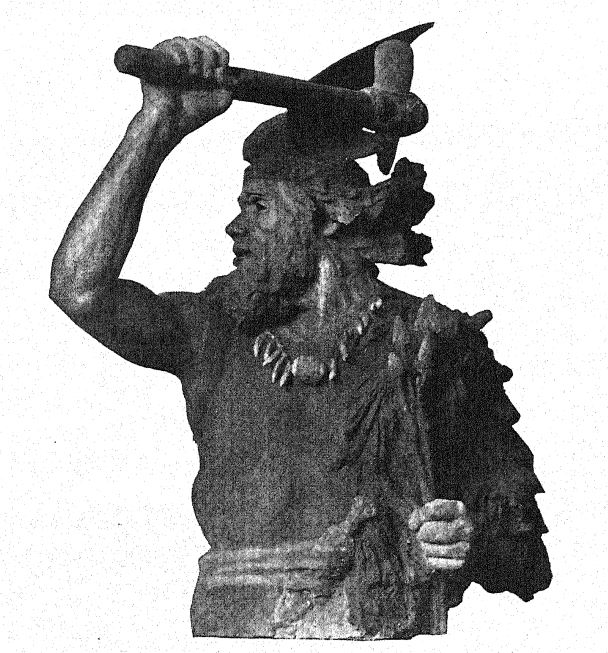
[ p. 496 ]
¶ Distinctive Features of the Neolithic Epoch
The first of these is the presence of implements of polished stone which find their way gradually into western Europe. The neoliths at first are greatly outnumbered by chipped and flaked implements, and some of the latter show a survival of the familiar types of the Old Stone Age, while others belong to entirely distinct types which had an independent development in the far East.
The chief economic change is seen in the rudimentary knowledge of agriculture and in the use of a variety of plants and seeds, accompanied by the gradual appearance of implements for the preparation of the soil and for harvesting the crops. This new i source of food supply leads to the establishment of permanent stations and camps and more or less to the abandonment of nomadic modes of life. Near the ancient camp sites and villages, therefore, are found implements for the preparation of skins and hides, because the chase was still maintained for purposes of clothing as well as for food.
Still more distinctive of the Neolithic is the introduction of pottery, which is at first used in the preparation of food. In the hearths or kitchen-middens and in the refuse heaps of the camps we no longer find evidence of the splitting of the jaws of mammals and of the long and short bones of the limbs, or even of the larger foot bones, in search of marrow, which is such a universal feature of the Upper Palaeolithic deposits.
The artistic impulse of the north is very crude and naturalistic. In the Spanish peninsula, accompanying and following the schematic period described in the early part of this chapter, there was a long stage of development in which men were painting on rocks, mostly in the form of silhouettes, naturalistic figures of animals and of people.24
The presence of the moose in these drawings concurs with that of the two bison represented in the cavern of Cogul and would tend to indicate that these paintings belong to Upper Palaeolithic times, and it is now considered that they are [ p. 497 ] of late Palseolithie age. The character of these animal designs is totally different from that of the Magdalenian period in the north and is analogous rather to that of the Bushmen of South Mrica. The authors of these frescos represent not only the ibex, stagj and wild cattle but also the horse, moose, fallow deer, wolf, and occasionally the birds. There are many features in this art which show its absolute independence of origin from that of the Magdalenian of the north, among them the frequent presence of composition and the almost invariable presence of human figures.

The frescos in the Spanish caverns of Alpera and of Cogul recall those of southern France but are almost always grouped in series of the chase, of encampment, and perhaps of war. This frequency of human figures, the representations of the bow and arrow, and the presence of a small arumal which may be recognized as the domesticated dog are indications of an entirely distinct race coming from the south and bringing in a new spirit in art which has no relation whatever to that of the Magdalenian.
[ p. 498 ]
¶ Neolithic Mammalian Life
Even in the oldest Neolithic deposits no trace of the horse as an object of food appears. The domestication of this animal was introduced from the east, and thus it ceased to be an object of the chase. The newly arriving tribes were undoubtedly attracted by the abundance of horses, both of the forest and Celtic types, which had survived from Upper Palaeolithic times. A very distinctive feature of the modern horses, however, should be mentioned, that is, the presence of a forelock covering the face, no trace of which is indicated in any of the Upper Palaeolithic carvings or engravings.
The wild animal life of western Europe at this time is a direct survival of the great Eurasiatic forest and meadow fauna which we have traced from the earliest Palaeolithic times. It includes the bison, the long-horned urus, the stag, the roe-deer, the moose, the wild boar, the forest horse, the Celtic horse, the beaver, the hare, and the squirrel. The fallow deer (Cervus dama) also appears more abundantly. Among the carnivora are the brown bear, the badger, the marten, the otter, the wolf, the fox, the wildcat, and the wolverene. The lion has disappeared entirely from western Europe. The reindeer sundves only in the north.
As observed above, two of these wild animals were early chosen by the invaders for domestication, namely, the plateau or Celtic horse and the forest horse. The former type is found in the Neolithic deposits of Essex, England. The wild urus (Bos primigenius) was hunted but was not domesticated.
Two new varieties of domestic cattle appear, neither of which has been previously observed in western Europe. The first of these is the ‘Celtic shorthorn’ (Bos longifrons), the probable ancestor of the small breeds of British short-horned and hornless cattle. The second is the ‘longhorn’ (Bos taurus), which shows some points of resemblance to the ‘urus’ (Bos primigenius) but is not directly related to it. Direct wild ancestors of this latter animal are said to occur in the Pleistocene of Italy. A [ p. 499 ] new type of pig also appears, the so-called turf pig (Sus scroja palustris ).
The Neolithic invaders, or men of the New Stone Age, thus brought with them, or domesticated from among the animals which they found in the forests of western Europe, a great variety of the same types of animals as those domesticated to-day, namely, cattle, sheep, goats, pigs, horses, and dogs.
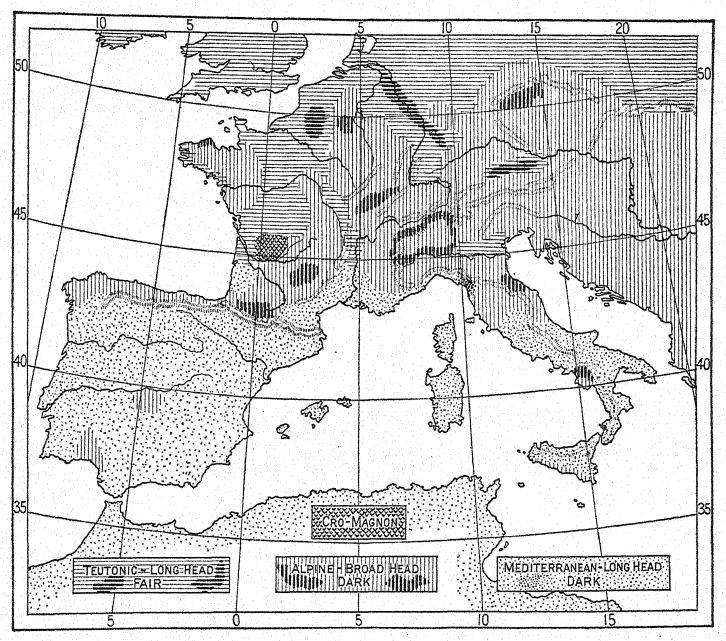
¶ The Prehistoric and Historic Paces of Europe
Before the close of Neolithic times all the direct ancestors of the modern races of Europe had not only established them [ p. 500 ] selves, but had begun to separate into those larger and smaller colonies which now mark out the great anthropological divisions of western Europe. It is therefore interesting to glance at the cranial distinctions of the men who successively entered western Europe in Upper Palaeolithic and Neolithic times. The upper part of the table corresponds with that of Ripley.25
| Type | Head | Face | Hair | Eyes | Stature | Nose | Cephalic Index Average per cent | |
|---|---|---|---|---|---|---|---|---|
| VI. | Teutonic (? Baltic). | Long, narrow. | High, narrow. | Very light. | Blue. | Tall. | Narrow, aquiline. | 75 |
| V. | Mediterranean (? Ofnet). | Long, narrow. | High, narrow. | Bark brown or black. | Bark. | Medium, slender. | Ratherbroad. | 75 |
| IV. | Alpine, Celtic (? Ofnet). | Round. | Broad. | Light chestnut. | Hazel gray. | Medium, stocky. | Variable; rather broad; heavy. | 87 |
| III. | FurfoozGrenelle (? Ofnet). | Broad. | Medium. | ? | ? | ? | ? | 79-85 |
| II. | Brünn PREDMOST (Moravia) . | Long. | Low, medium. | ? | ? | ? | ? | 68.2 or 65.7 |
| I. | Crò-Magnon. | Long. | Low and broad. | ? | ? | Tall to medium. | Narrow, aquiline. | ? 63 ? 76.27 |
MODERN, NEOLITHIC, AND UPPER PALEOLITHIC EUROPEAN RACES OF THE EXISTING SPECIES OF MAN (HOMO SAPIENS)
It would appear that five out of these six great racial types had entered Europe before the close of Upper Palaeolithic times, namely, I to V in the above table.
How about the sixth type ; the narrow-headed, light-haired people of the north, the modern Teutonic type? This question cannot be answered at present. We have, however, high authority [ p. 501 ] for the invasion of a new northern race, which may have been of the Teutonic type, as occurring before the close of Paleolithic times. These were the people described above, migrating along the shores of the Baltic with a new northern Maglemose culture and crude naturalistic art.
¶ Conclusions As To The Old Stone Age
The above outline of the beginnings of the Neolithic Age shows that the Paleeolithic represents a complete cycle of human development; we have traced its rise, its perfection, its decline. During this dawning period of the long prehistory of Europe the dominant features are the very great antiquity of the spirit of man and the fundamental similarity between the great steps of prehistory and of history. The rise of the spirit of man through the Old Stone Age cannot be traced continuously in a single race because the races were changing ; as at the present time, one race replaced another, or two races dwelt side by side. The sudden appearance in Europe at least 25,000 years ago of a human race with a high order of brain power and ability was not a leap forward but the effect of a long process of evolution elsewhere. When the prehistoric archaeology of eastern Europe and of Asia has been investigated we may obtain some light on this antecedent development.
During this age the rudiments of all the modern economic powers of man were developed : the guidance of the hand by the mind, manifested in his creative industry ; his inventive faculty ; the currency or spread of his inventions ; the adaptation of means to ends in utensils, in weapons, and in clothing. The same is true of the esthetic powers, of close observation, of the sense of form, of proportion, of symmetry; the appreciation of beauty of animal form and the beauty of line, color, and form in modelling and sculpture. Finally, the schematic representation and notation of ideas so far as we can perceive was alphabetic rather than pictographic. Of the musical sense we have at present no evidence. The religious sense, the appreciation of [ p. 502 ] some power or powers behind the great phenomena of nature, is evidenced in the reverence for the dead, in burials apparently related to notions of a future existence of the dead, and especially in the mysteries of the art of the caverns.
All these steps indicate the possession of certain generic faculties of mind similar to our own. That this mind of the Upper Palaeolithic races was of a kind capable of a high degree of education we entertain no doubt whatever because of the very advanced order of brain which is developed in the higher members of these ancient races ; in fact, it may be fairly assumed from experiences in the education of existing races of much lower brain capacity, such as the Eskimo or Fuegian. The emergence of such a mind from the mode of life of the Old Stone Age is one of the greatest mysteries of psychology and of history.
The rise and fall of cultures and of industries, which is at this very day the outstanding feature of the history of western Europe, was fully typified in the very ancient contests with stone weapons which were waged along the borders of the Somme, the Marne, the Seine, and the Danube. No doubt, each invasion, each conquest, each substitution of an industry or a culture had within it the impelling contest of the spirit and will of man, the intelligence directing variqus industrial and warlike implements, the superiority either of force or of mind.
¶ Bibliography
(1) Cartailhac, 1903.1, pp. 330, 331
(2) Dechelette, 1908.1, voL I, pp. 314-320.
(3) Op. cit., p. 320.
(4) Op. cit., pp. 505-510.
(5) Breuil, 1912.6, pp. 2-6.
(6) Ibid., 1912.7; pp. 232, 233.
(7) Ibid., 1912.6, p. 20.
(8) Koken, 1912.1, pp. 172, 173, 176 1785 180, 181, 201.
(9) Schmidt, 1912.1,9.40.
(10) Breuil, 1912. 7, p. 225.
(11) Op. cit., p. 233.
(12) Schmidt, 1912.1, p. 41. ,
(13) Schliz, 1912.1, pp. 242-244.
(14) 0p. cit., p. 252.
(15) Boule, 1913.1, p. 210.
(16) Dupont, 1871.1.
(17) Fischer, 1913.15 P- 3 S 6 *
(18) Breuil, 1912.5.
(19) Ibid., 1912.7, pp. 235, 236.
(20) Obermaier, 1912.1, pp. 467-469.
(21) Salmon, 1898.1.
(22) Munro, 1912.1, pp. 275“277.
(23) Dechelette, 1908.1, voL 1 , p. 326.
(24) Breuil, 1912.5, p. 560.
(25) Ripley, 1899,1, p. 121.